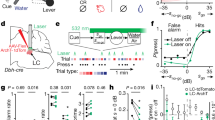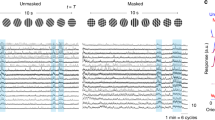Abstract
HABITUATION, or response decrement, functions to reduce an animal's responsiveness to maintained or frequently repeated stimuli, while ensuring high responsiveness to novel stimuli. Under some circumstances, however, habituation is inappropriate, in response to sensory afference caused by an animal's own activities, for example. Mechanisms for protection from habituation under such circumstances are likely to be common. Here we show, in locust movement detector (MD) neurones, that whereas habituation is rapid in response to repeated small field movements it is absent in response to maintained whole field movements. Prolonged whole field movements do not therefore reduce the responsiveness of the MD neurones to subsequent small field movements. Protection from habituation is achieved by lateral inhibition which acts prior to the site of response decrement to suppress the response to whole field stimuli.
This is a preview of subscription content, access via your institution
Access options
Subscribe to this journal
Receive 51 print issues and online access
$199.00 per year
only $3.90 per issue
Buy this article
- Purchase on Springer Link
- Instant access to full article PDF
Prices may be subject to local taxes which are calculated during checkout
Similar content being viewed by others
References
Burrows, M., and Rowell, C. H. F., J. comp. Physiol., 85, 221–234 (1973).
O'Shea, M., Rowell, C. H. F., and Williams, J. L. D., J. exp. Biol., 60, 1–12 (1974).
O'Shea, M., and Williams, J. L. D., J. comp. Physiol., 91, 257–266 (1974).
O'Shea, M., and Rowell, C. H. F., J. comp. Physiol., 95 (in the press).
Palka, J., J. exp. Biol., 50, 723–732 (1969); Am. Zool., 12, 497–505 (1972).
Horn, G., and Rowell, C. H. F., J. exp. Biol., 49, 143–169 (1968).
Rowell, C. H. F., Z. vergl. Physiol., 73, 167–194 (1971).
Palka, J., J. Insect Physol., 13, 235–248 (1967).
Ratliff, F., and Hartline, H. K., J. gen. Physiol., 42, 1241–1255 (1959).
Barlow, H. B., in Sensory communication (edit. by Rosenblith, W. A.), 782–786.
Krasne, F. B., and Bryan, J. S., Science, 182, 590–592 (1973).
Kennedy, D., Calabrese, R. L., and Wine, J. J., Science, 186, 451–454 (1974).
Author information
Authors and Affiliations
Rights and permissions
About this article
Cite this article
O'SHEA, M., ROWELL, C. Protection from habituation by lateral inhibition. Nature 254, 53–55 (1975). https://doi.org/10.1038/254053a0
Received:
Revised:
Issue Date:
DOI: https://doi.org/10.1038/254053a0
This article is cited by
-
A model of feedforward, global, and lateral inhibition in the locust visual system predicts responses to looming stimuli
Biological Cybernetics (2021)
-
Characterization and modelling of looming-sensitive neurons in the crab Neohelice
Journal of Comparative Physiology A (2018)
-
Two identified looming detectors in the locust: ubiquitous lateral connections among their inputs contribute to selective responses to looming objects
Scientific Reports (2016)
-
Response properties and receptive field organization of collision-sensitive neurons in the optic tectum of bullfrog, Rana catesbeiana
Neuroscience Bulletin (2010)
-
Role of spike-frequency adaptation in shaping neuronal response to dynamic stimuli
Biological Cybernetics (2009)
Comments
By submitting a comment you agree to abide by our Terms and Community Guidelines. If you find something abusive or that does not comply with our terms or guidelines please flag it as inappropriate.



